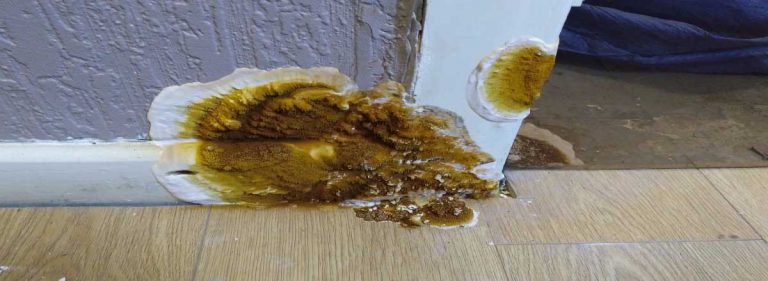
In order to fix damp and timber problems, a one-size-fits-all solution can’t be applied. Instead, Garratt’s Damp & Timber LTD offers a bespoke solution by surveying your home and employing a customised method suited to your unique issue. You can see just how versatile our services are by visiting our case studies page, which displays all manner of damp solutions on various properties.
As far as dry rot is concerned, mushrooms belong on your plate, not your walls. Therefore, watching the rapid spread of dry rot, a fungal growth, through your building can be a shock and somewhat worrying.
Damage Caused by Dry Rot
Dry rot can be highly damaging to the timber structure of a property. The spores of dry rot germinate in the pores of the timber, resulting in vegetation that feeds on the timber before spreading to produce a fruiting body. This fruiting body will release more spores, and the cycle will continue.
The timber structure will shrink and crack, become brittle, and take on a darker colour. These signs are also typical of wet rot – the difference is that with dry rot, the shrinking of the timber will create cuboidal cracking. The depth of this cracking is more significant in dry rot than in wet.
Dry rot usually migrates behind plastered and rendered walls in search of more timber. Thus, it also damages the masonry within the house, not just the timber.
Immediate Action Required
Suppose you are suspicious of dry rot infecting the timber in your home. In that case, you must get it confirmed and treated as soon as possible, as dry rot can spread from house to house and rapidly eat away at the very foundation and structure of a property.
A survey carried out by Garratt’s Damp & Timber will diagnose the problem and put together a treatment plan that will eradicate the problem quickly and permanently.
What does dry rot look like?
The vegetative (mycelium) part of the fungus exhibits different appearances. Commonly a silvery-grey skin with lilac and yellow colouration or a white cotton wool-like carpet, which is usually seen in more humid environments.
The fruiting body is a large, fleshy plate that can grow across timber, masonry, and soil. The body appears reddish-brown, with an outer perimeter of white with orange patches.
How do I know I have dry rot?
You need to look out for the following symptoms:
- A musty, damp smell in the room/building
- Damaged/decaying timber that may also feature grey strands and generally deep cuboidal cracks
- Patches of spore dust that may appear red, orange, or brown.
- Large mushroom-like bodies growing on the timber
- Weak timber that easily crumbles in the hand
- Movement in the floors
- Sap between skirting boards and floors or between architraves and walls
If you are worried or concerned that you may have dry rot, contact Garratt’s immediately and book a survey. Dry rot spreads rapidly and could cause significant damage to both your own and neighbouring properties.
What causes dry rot?
The presence of dry rot spores, individually invisible to the naked eye, is the crucial component for any infestation, but these spores on their own will not result in the spreading of dry rot. For this, the spores must come into contact with moist timber (the timber must be above 28% moisture content) for mushrooms to begin to form.
The main causes of dry rot in a property are:
- High moisture content in wood, which allows the fungus to establish itself, usually due to gutter leaks, plumbing leaks, roofing defects and defective drains.
- Poorly ventilated environments where high levels of condensation can occur
Usually, dry rot manifests in an area of the building that can easily be forgotten and poorly ventilated, leaving the humid atmosphere that provides the ideal breeding ground for bacteria and rot. This is why many homeowners feel as though the manifestation of dry rot has almost snuck upon them, with common areas of homes including basements, sub-floors and lofts where dry rot is most common.
How do we treat dry rot?
In order to treat dry rot and ensure that the infestation does not return, the overriding issue of dampness in the area must first be addressed. By simply repairing/replacing any affected timber without any other action, sooner or later, the dry rot will return and damage the newly repaired timber.
Poorly ventilated rooms suffering from condensation should be fitted with additional ventilation. It is important that all rooms are allowed to breathe to prohibit the build-up of moisture which can lead to issues such as dry rot, as well as other forms of damp that can be equally as destructive to the building and its foundation.
The next step is to eradicate the rot through the removal and replacement of the affected timber and masonry. Any timbers that remain in place will need sterilising in order to completely eradicate any lingering spores that could easily manifest into a fresh dry rot infestation. Irrigation and sterilisation will also be required for any exposed areas where contaminated masonry is removed.







